Low rainfall pulse production: one pulse does not fit all
Low rainfall pulse production: one pulse does not fit all
Author: Sarah Day, Penny Roberts (SARDI, Clare; University of Adelaide) and Amy Gutsche (SARDI, Pt Lincoln) | Date: 27 Jul 2021
Take home messages
- PBA Samira faba bean, Volga vetch, PBA Bolt lentil, PBA Hallmark XT lentil, PBA Butler field pea, and PBA Wharton field pea have shown improved crop performance in low rainfall environments compared to other varieties of their respective crop species.
- It is important to follow an integrated disease management approach, select varieties with disease resistance, monitor pulse crops for disease infection and apply foliar fungicides at the first sign of disease prior to rain.
- Faba bean and chickpea show a consistent trend in response to time of sowing – this information allows growers flexibility in their seeding program. The grain yield response in lentil to time of sowing is complex, with location and environmental limiting factors having an impact on the yield response.
- Pulse-oilseed intercropping has the potential to increase both productivity and gross margin return in low rainfall environments of South Australia.
Background
Pulse crop production has expanded into the low rainfall cropping regions of South Australia in the last decade, as adoption of direct drilling and continuous cereal cropping has increased the need to include break crops. The production shift also reflects recent high grain prices for some pulse crops and the developments in pulse breeding, particularly the introduction of varieties with improved herbicide tolerance characteristics and those better adapted to low rainfall environments. Faba bean, chickpea, lentil, vetch and lupin production in the low rainfall zone has increased since 2012, with the largest increases in area sown to chickpea, lentil and vetch (Figure 1). Field pea is the only pulse that has seen a reduction in production area, with this in part due to the disease risk for field pea and higher grain prices for alternative pulse options. The western and eastern Eyre Peninsula regions have seen a decrease in field pea production, while production of vetch and lentil has increased (Figure 2). Whilst growers in low rainfall regions have increased their production area to pulses, the challenge of best management strategies for resource and economic efficiency remains.

Figure 1. Change in total production area (ha) of pulse crops in the South Australian low rainfall regions (western Eyre Peninsula, eastern Eyre Peninsula, Upper North, Lower Murray, Murray Mallee), shows an increase in lentil, chickpea and vetch production, 2012 to 2020 (PIRSA 2012-2020).
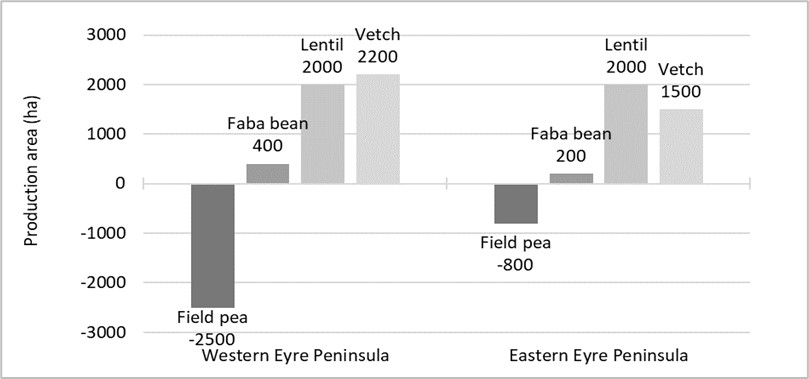
Figure 2. Western and eastern Eyre Peninsula regions have seen a reduction in the area (ha) sown to field pea and increases in area of lentil and vetch, 2012 to 2020 (PIRSA 2012-2020).
The majority of pulse management strategies, including plant densities, fertiliser rates, disease and weed options have been developed based on production in the medium and high rainfall zones. Strategies developed in these environments are often not viable or economical for growers in low rainfall regions. To improve grower confidence in increasing pulse production within the low rainfall region there is a need for pulse management strategies developed specifically for low rainfall environments. In particular, novel approaches and management strategies to reduce or diversify economic risk, as well as strategies to reduce input costs without compromising production potential are needed.
This paper highlights research findings in low to medium rainfall environments in South Australia, 2015-2020, including variety selection and time of sowing. A comparison between vetch and lentil production potential and optimum seeding rate is also discussed, in view of the expansion of these two crops and an increased interest in the potential of lentil production for grazing or hay.
Results and discussion
Crop adaptation and variety selection
Lentil
PBA Hallmark XT and PBA Bolt, with improved tolerance to boron and salt over other lentil varieties, have shown improved adaptation in low rainfall environments (Day, Oakey et al. 2019). PBA Bolt offers early to mid-flowering and maturity, lodging resistance, improved boron and salt tolerance, and high grain yield in drought years and dry areas. PBA Hallmark XT, progeny of PBA Bolt crossed with PBA Herald XT, offers improved herbicide tolerance to conventional lentil varieties, and would be well suited to areas or seasons where Group B herbicide residues are an issue. PBA Jumbo2 is the highest yielding red lentil variety in South Australia and would be a good fit in farming systems free of herbicide residues and soil constraints. New lentil variety releases may have improved adaptation in these environments compared to the former varieties, however evaluation has been somewhat limited. PBA Highland XT is a medium seed size red lentil with improved herbicide tolerance and is showing adaptation to drier lentil-growing regions of the Victorian Mallee and South Australia.
Common vetch
Early maturing vetch variety Volga has high grain and biomass yield potential and has proven to be a top performing vetch variety across low rainfall environments. Studenica is a new white flowering common vetch variety that has been bred for low rainfall areas and is particularly well suited to short seasons (Nagel, Kirby et al. 2021). Studenica can play a key role in a mixed farming system by offering early feed to fill the winter feed gap.
Faba bean
PBA Samira has performed better than PBA Bendoc for grain and biomass yield across low rainfall environments. When sown in May, production from PBA Samira is similar, or better than, PBA Marne, a low rainfall or short season adapted variety. However, when sown early, PBA Marne and PBA Bendoc show better adaptation than PBA Samira.
Field pea
Conventional field pea varieties have high biomass production potential and are better suited to alternative end-uses to grain production. However, conventional field pea types have not offered improved biomass production over semi-leafless varieties in low rainfall environments (Day, Oakey et al. 2019). Additionally, conventional type field pea, such as PBA Percy, are more susceptible to lodging, therefore, semi-leafless varieties may be a more suitable option regardless of target end use. PBA Butler, PBA Twilight and PBA Wharton have been the higher yielding field pea varieties in low rainfall environments (Day, Oakey et al. 2019).
Chickpea
Desi chickpea variety PBA Striker recorded higher grain yield across low rainfall environments compared to kabuli varieties. Desi chickpea is generally earlier maturing than kabuli chickpea and may be better suited to short seasons and low rainfall environments. Newer chickpea variety releases may have improved adaptation to the low rainfall zone, however evaluation has been limited in these environments. PBA Royal is an early to mid-flowering kabuli chickpea that is well adapted to the medium-rainfall chickpea growing regions of south-eastern Australia (greater than 1.5 t/ha).
Time of sowing
Lentil
The grain yield response in lentil to time of sowing is complex, with location and environmental limiting factors having an impact on the yield response. The broad range of agronomic characteristics in commercial lentil varieties compared to other pulses in southern Australia contributes to this complexity. An understanding of the differences in the agronomic characteristics and how they interact with the environment and potential constraints is important for variety selection. In general, early sowing is beneficial, with the newer varieties better adapted to early sowing than traditional varieties such as Nugget (Roberts, Walela et al. 2019). However, constraints including weeds, disease, high biomass, and frost during reproductive phases will reduce the benefits of early sowing. Mixed responses to time of sowing were observed on the Eyre Peninsula in 2020 (Figure 3 & 4). At Wudinna, grain yield of PBA Bolt increased by 81% from early sowing on 31 March compared to 7 May, however, PBA Jumbo2 and PBA Highland XT did not benefit from early sowing. Early sowing of lentil on 2 April did not alter grain yield compared to sowing on 6 May at Tooligie in 2020, likely due to frost events during reproductive growth stages.
Faba bean
There is a consistent positive yield response to early sowing for faba bean in the medium rainfall zone, providing there is an early season break and adequate soil moisture. Some varieties, including Nura and PBA Samira, showed greater yield stability across all times of sowing (Roberts, Walela et al. 2019). Therefore, if later sowing times are required to fit into the seeding program, these varieties would be better options than PBA Bendoc. Similar responses were observed at two sites on the Eyre Peninsula in 2020 (Figure 3 & 4). At Tooligie, a yield increase of between 36 and 78% was achieved from early sowing, while an increase of 32-193% from early sowing was observed at Wudinna, with the greatest response for PBA Bendoc and PBA Marne (Gutsche, Roberts et al. 2021). Where an early season break did not occur, and soil moisture levels were low at the early sowing time there was no yield advantage as the faba beans were unable to establish early (data not shown).
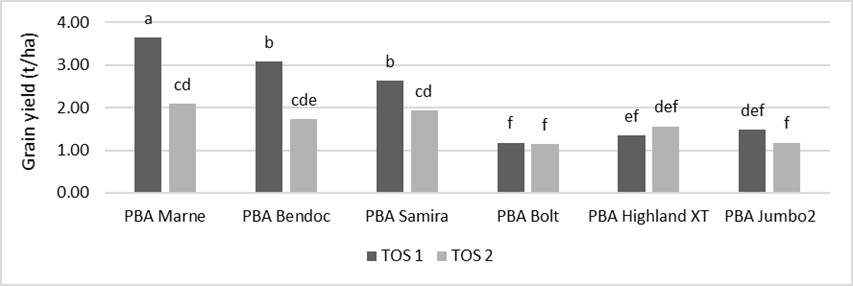
Figure 3. Grain yield (t/ha) of faba bean and lentil varieties sown over two times of sowing (ToS 1 = 2 April, ToS 2 = 6 May,) at Tooligie, 2020. Bars labelled with the same letters are not significantly different (P<0.05). 10 mm of supplementary irrigation was provided via dripper irrigation in-furrow immediately post -April sowing and pre-May sowing within a couple of days to simulate a singular rainfall event.
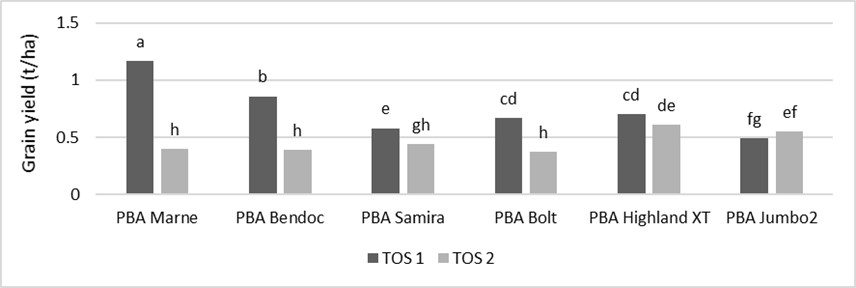
Figure 4. Grain yield (t/ha) of faba bean and lentil varieties sown over two times of sowing (ToS 1 = 31 March, ToS 2 = 7 May) at Wudinna, 2020. Bars labelled with the same letters are not significantly different (P<0.05). 10 mm of supplementary irrigation was provided via dripper irrigation in-furrow immediately post -April sowing and pre-May sowing within a couple of days to simulate a singular rainfall event.
Vetch
Time of sowing for vetch is dependent on the target end-use. Early sowing is vital for grazing and green or brown manure, to allow the crop to establish early while the soil is warm (Nagel, Kirby et al. 2021). Time of sowing for hay production is dictated by when the cutting and drying window will occur for the specific variety, while early canopy closure is important to out-compete weeds. Variety response to time of sowing was varied due to differences in phenology characteristics (Figure 5 & 6). Very early maturing vetch variety Studenica benefitted from later sowing, as sowing too early exposed early pods to cold and frosty temperatures, while late maturing variety Morava benefitted from early sowing. Volga showed the greatest stability in production across time of sowing, however sowing early was not beneficial to early biomass production in this variety (data not shown).
Field pea
Sowing field pea early can increase the exposure to blackspot spores over a longer period and increase vegetative growth leading to increased risk of leaf disease resulting in yield loss. Sowing early also exposes flowers and early pods to frosty conditions, and just one frost event is enough to significantly reduce grain yield, as seen at Eudunda in 2020, where early sowing reduced field pea grain yield by 15-28% (Figure 6). Hence, field pea is better suited to May sowing, to reduce disease risk and avoid pod development during cold temperatures.
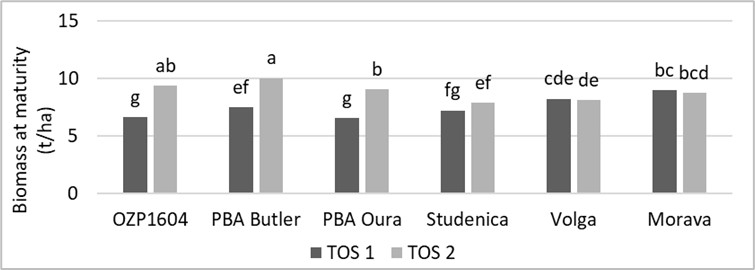
Figure 5. Biomass production (t/ha) of field pea and vetch varieties with varying phenology characteristics sown across two times of sowing (ToS 1 = 2 April, ToS 2 = 4 May), Eudunda 2020. Bars labelled with the same letters are not significantly different (P<0.05). 20 mm of supplementary irrigation was provided via dripper irrigation in-furrow immediately post -April sowing and pre-May sowing within a couple of days to simulate a singular rainfall event.
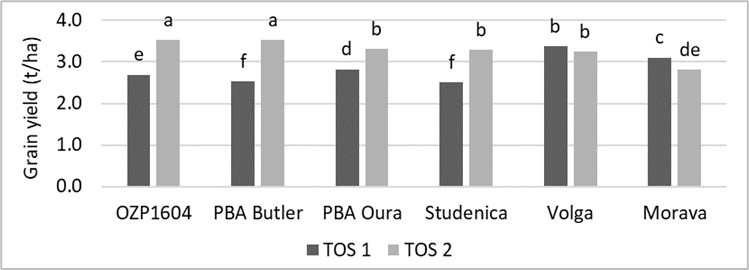
Figure 6. Grain yield (t/ha) of field pea and vetch varieties with varying phenology characteristics sown across two times of sowing (ToS 1 = 2 April, ToS 2 = 4 May), Eudunda 2020. Bars labelled with the same letters are not significantly different (P<0.05). 20 mm of supplementary irrigation was provided via dripper irrigation in-furrow immediately post -April sowing and pre-May sowing within a couple of days to simulate a singular rainfall event.
Disease management
Lentil
Lentil crops should be monitored for Ascochyta Blight (AB), as well as Botrytis Grey Mould (BGM) in higher rainfall seasons or where crops have large canopies. Growers should monitor lentil crops for disease infection and plan to spray infected crops ahead of rain fronts during podding to protect the developing seed. Fungicides may be required in wet springs to control BGM. There are lentil varieties with high disease resistance ratings (e.g. PBA Jumbo2) that can be utilised to reduce the need for fungicide applications without compromising yield potential.
Vetch
An integrated disease management program is very important for vetch production as there are few fungicides registered for use in this crop. Some of these registered fungicides have long withholding periods, and therefore, should be avoided if the vetch crop is being cut for silage or hay destined for the dairy industry (GRDC 2018). It is important to consider the ability to control AB in vetch, as well as BGM and rust in higher rainfall seasons or where crops grow large quantities of biomass. There are fungicides registered for the control of BGM but the need for multiple sprays in conducive seasons may not be economical (Davidson and Noack 2018). Grazing vetch will open up the canopy allowing it to dry out and prevent disease infection. Rust can impact vetch growth and yield and it is very important not to graze or cut infected vetch crops for hay or silage as it can induce abortions in pregnant stock (Davidson and Noack 2018, GRDC 2018).
Field pea
For field pea, the control of blackspot with fungicides is not economically viable where grain production is less than 1.5t/ha. Where grain production potential is greater than 1.5t/ha, newer fungicide options have been effective in reducing disease and improving grain yield in early sown crops and high disease situations (Walela, Roberts et al. 2018). Blackspot can be reduced using a fungicide strategy of P-Pickel T® seed dressing combined with two foliar fungicide sprays (four to nine weeks post sowing and again at early flowering). In seasons where disease infects a crop that is unlikely to achieve 1.5 t/ha grain yield potential, growers should consider crop salvage options, such as grazing, that may improve economic outcomes. Predictions of blackspot risk and spore release times in each field pea growing district can be obtained through ‘Blackspot Manager’ online.
Faba bean
Faba bean crops need to be monitored for AB and chocolate spot (CS) as well as rust. Growers should monitor faba bean crops for AB infection and plan to spray infected crops ahead of rain fronts during podding to protect the developing seed. There are faba bean varieties with high AB resistance (e.g., PBA Samira) that reduce the need for fungicide applications. Flowers are particularly susceptible to CS and fungicides may be required during wet springs to protect against this disease. Growers should monitor crops for rust and spray at the first sign of disease.
Chickpea
In recent years high levels of AB infection have been found in chickpea crops across South Australia, even in lower rainfall environments. This has seen a reduction in resistance ratings in commercial varieties, leading to all varieties being rated as either susceptible or moderately susceptible. Growers need to carefully consider their risk of AB infection and their ability to effectively control the disease prior to making the decision to grow chickpea in the southern region. It is essential that all chickpea seed is treated with a thiram-based fungicide seed dressing to prevent early infection on seedlings, as the disease will survive on stubble and organic matter for numerous years. It is important to monitor crops for signs of infection and apply fungicides ahead of rain, particularly during reproductive growth stages, to protect developing seeds.
Lentil vs. vetch – reducing inputs and diversifying production
With a reduction in area sown to field pea in South Australia, growers are choosing to grow vetch, a versatile break crop, and are considering the potential of other pulse break crop options for alternative end uses. There are many unfavourable aspects of vetch production, including poor early weed competition, limited herbicide options, hard seediness of some varieties, poor harvestability and market access. Using lentil for grazing or hay is growing in interest among low rainfall growers, which initiated research trials comparing biomass and grain production of vetch and lentil sown at multiple seeding rates, at four trials sites in 2020. The seeding rates compared recommended target plant density (120 plants/m2 for lentil and 60 plants/m2 for vetch) with a target density of half and three-quarters of the recommended rate, to assess whether input costs could be reduced without compromising production potential. Higher than recommended rates were not included, as high plant density crops increase the risk of disease infection and lodging and reduce the resource efficiency due to larger canopies. At three of the four sites seeding rate could be reduced by a quarter without compromising biomass or grain production in 2020 (Table 1). Reducing the seeding rate further to half of the target density did reduce production at some sites. A seeding rate that is too low exposes the crop to aphid infestation and weed establishment and the crop is more difficult to harvest. Previous preliminary trials on seeding rate in lentil at Melton, and vetch at Willowie, support these findings that seeding rate can be reduced (to a point) without compromising production under some seasonal conditions.
Table 1. Biomass and grain production (t/ha) responses to multiple seeding rates of lentil and vetch at four sites, 2020. LSD = least significant difference (P<0.05). n.s. = not significant (>0.05)
Seeding rate | Eudunda | Booleroo | Kimba | Stokes | ||||
|---|---|---|---|---|---|---|---|---|
Biomass yield | Grain yield | Biomass yield | Grain yield | Biomass yield | Grain yield | Biomass yield | Grain yield | |
Recommended | 5.2 | 3.0 | 5.2 | 2.6 | 1.7 | 0.8 | 2.6 | 1.7 |
Three-quarter | 4.8 | 3.0 | 4.8 | 2.7 | 1.6 | 0.7 | 2.2 | 1.6 |
Half | 4.4 | 2.8 | 4.5 | 2.6 | 1.5 | 0.7 | 2.0 | 1.5 |
LSD (P<0.05) | 0.5 | n.s. | n.s. | n.s. | n.s. | n.s. | 0.36 | n.s. |
Where vetch is not favoured as a break crop, lentil can be a versatile option. Lentil hay could be cut to salvage a financial return where the crop is severely affected by frost, heat, or drought. For the 15 break crop trials in the southern region, lentil was better than or equal to vetch (vetch = lentil) for biomass production in 7 trials, for grain production in 10 trials and for profit in 9 trials (Table 2). Lentil production and profit was greater than vetch at two sites and in these cases, crops were affected by frost or dry spring seasonal conditions. Lentil can be utilised as a lower risk and versatile crop option as an alternative to vetch, with greater market access for lentil grain and increased interest in lentil hay. Feed analysis shows minimal difference in the feed quality of lentil and vetch hay (Table 3), and in recent years lentil crops have been profitable where hay was cut due to severe frost damage.
Table 2. Frequency of break crop trials where vetch biomass and grain production and profit from grain production was equal, greater than, or less than lentil, 2017-2020.
Biomass | Grain | Profit (grain) | TOTAL | |
|---|---|---|---|---|
Lentil ≥ Vetch | 7 | 10 | 9 | 26 |
Lentil < vetch | 7 | 4 | 1 | 12 |
Table 3. Feed analysis results of lentil and vetch cut for hay at early pod development growth stage.
Lentil | Vetch | |
|---|---|---|
Crude Protein (% of dry matter) | 19.2 | 21.2 |
Digestibility (% of dry matter) | 77.6 | 78.2 |
Metabolisable Energy (MJ/kg dry matter) | 11.7 | 11.8 |
Intercropping
Pulse-oilseed intercropping is a system that is shown to provide production and sustainability benefits in low rainfall cropping systems (Roberts and Day 2021). From seven field trials in four years productivity gains (measured using Land Equivalent Ratio) of up to 40% were achieved, 40-50% of the time where chickpea, lentil and vetch were intercropped with canola compared to growing the crops as monocultures (Roberts, unpublished). Gross margin returns for intercrops with canola were generally similar or more favourable than the sole crops for field pea, chickpea, and lentil. The additional complexity of intercropping systems includes logistical challenges during sowing, harvest, handling, and grain storage. With careful planning considering species mix, variety selection, logistics of seeding, weed control, and harvest, these systems can be successfully adopted to a broadacre scale as demonstrated by grower adoption of intercropping in Australia.
Conclusion
The decision to grow a break crop is generally done with a whole systems approach, as break crops can be utilised to address the issues and constraints that arise from continuously cropping cereals. The choice of break crop is dependent on a number of factors: crop end-use, fit into the sowing program and farming system, financial risk, paddock selection, and soil type.
The ability to control foliar disease in pulse crops needs to be carefully considered prior to growing these crops and an integrated approach is essential. For disease management it is important to follow recommendations on seed and paddock hygiene, select varieties with improved disease resistance where possible, monitor paddocks for disease infection and apply fungicides at first sign of disease prior to rain fronts.
The results from time of sowing trials gives growers more confidence in deciding when to sow each pulse crop, and variety selection to suit their individual seeding program.
Acknowledgements
The research undertaken as part of these projects (DAS00162A and DAV00150) is made possible by the significant contributions of growers through both trial cooperation and the support of the GRDC, the author would like to thank them for their continued support.
Useful resources
NVT South Australian Crop Sowing Guide
Field pea blackspot management guide for South Australia
References
Davidson, J. and S. Noack (2018) Disease management of pulses in low to medium rainfall zones. In 'GRDC Grains Research Updates'. (Ed ORM)
Day, S., H. Oakey and P. Roberts (2019) A systems approach to break crop selection in low rainfall environments. 19th Australian Agronomy Conference, Wagga Wagga, NSW, Australia
GRDC (2018) GRDC Grow Notes - Vetch.
Gutsche, A., P. Roberts and D. Bruce (2021) Exploiting the indeterminate nature of pulses. In 'Eyre Peninsula Farming Systems Summary 2020'. (Eds A. Cook, N. Wilhelm, F. Tomney et al. Port Lincoln) pp.122-125.
Nagel, S., G. Kirby and A. Kennedy (2021) "Studenica" a new comon vetch variety offering early grazing options. In 'Eyre Peninsula Farming Systems Summary 2020'. (Eds A. Cook, N. Wilhelm, F. Tomney et al. Port Lincoln) pp. 120-121.
Nagel, S., G. Kirby and A. Kennedy (2021) Vetch agronomy and management. In 'GRDC Grains Research Updates'. (Ed ORM)
PIRSA (2012-2020) Crop and Pasture Reports South Australia. G. o. S. A. D. o. P. Industries.
Roberts, P. and S. Day (2021) Mixed species cropping and intercropping: where, how and why? In 'Eyre Peninsula Farming Systems Summary 2020'. (Eds A. Cook, N. Wilhelm, F. Tomney et al. Port Lincoln) pp.131-134.
Roberts, P., C. Walela, L. McMurray and H. Oakey (2019) South Australian pulse research update - multi-season results. In 'GRDC Grains Research Updates 2019 Adelaide'. (Eds ORM)
Walela, C., P. Roberts, R. Mould, B. Spriggs, L. McMurray and J. Davidson (2018) Ascochyta blight severity and yield response to fungicides in field pea. In 'Trial Results 2018. H. F.-S. Group' pp.58-64.
Contact details
Sarah Day
70 Farrell Flat Road, Clare SA 5453
0409 109 285
Sarah.Day@sa.gov.au
@Sarah_Day_
GRDC Project Code: DAS00162A, DAV1706-003RMX,
